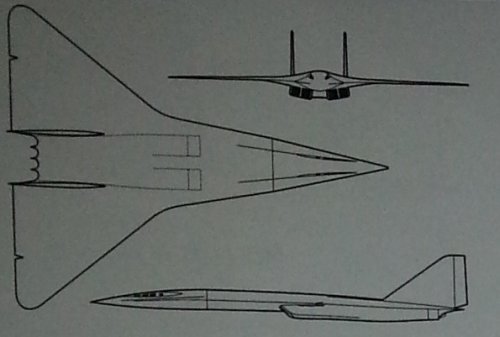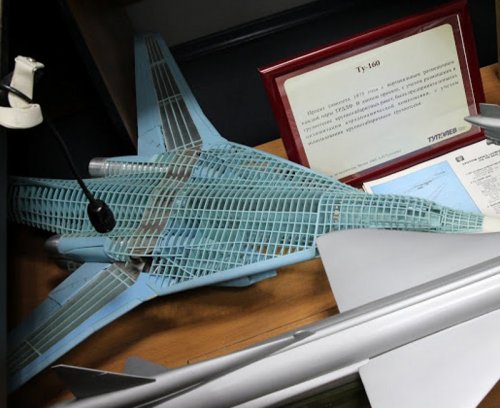You are using an out of date browser. It may not display this or other websites correctly.
You should upgrade or use an alternative browser.
You should upgrade or use an alternative browser.
Tupolev Tu-160 projects
- Joined
- 26 May 2006
- Messages
- 34,744
- Reaction score
- 15,606
flateric said:They both were not hypersonic. '139' on the top picture (one of the times this designation was used) is a supersonic launcher platform.for '136' with R-14 based booster stage. Here's a different variant of '139'.
http://www.uhlib.ru/transport_i_aviacija/aviacija_i_kosmonavtika_2009_08/p3.php
Thanks.
martinbayer
ACCESS: Top Secret
- Joined
- 6 January 2009
- Messages
- 3,334
- Reaction score
- 3,797
In the mid-nineties there was a proposal of a demilitarized commercial version of the Tu-160 called Tu-160SK that was intended as the launch platform for an expendable small launch vehicle named Burlak, see http://www.astronautix.com/b/burlak.html and http://www.testpilot.ru/russia/tupolev/160/sk/160sk.htm. A mocked up version was apparently presented at Asian Aerospace in Singapore in 1994.
Martin
Martin
- Joined
- 2 January 2006
- Messages
- 3,804
- Reaction score
- 4,950
PaulMM (Overscan) said:Moved to Tu-160 topic.
Pictures are from Vladimir Rigmant's Tu-160 book by Polygon Press. This is a really awesome book made with close cooperation with Tupolev, marred only (for non-Russian speakers) by being written in Russian. It pays particular attention to the early projects and configuration development of the Tu-160, which makes it especially interesting for this forum, and large numbers of original Tupolev OKB drawings and illustrations are presented.
Interesting concept, but did anyone notice the similarities of the Tu-170 and that alleged JH-XX/H-18 regional bomber concept ?
Attachments
blackkite
Don't laugh, don't cry, don't even curse, but.....
- Joined
- 31 May 2007
- Messages
- 8,789
- Reaction score
- 7,602
Hi! Double delta wing+Twin vertical tail stabilizer⇒VG double delta wing+single vertical tail stabilizer⇒Double delta wing+single vertical tail stabilizer.
https://forums.somethingawful.com/showthread.php?threadid=3276654&pagenumber=387&perpage=40#post421371326
https://forums.somethingawful.com/showthread.php?threadid=3276654&pagenumber=387&perpage=40#post421371326
Attachments
blackkite
Don't laugh, don't cry, don't even curse, but.....
- Joined
- 31 May 2007
- Messages
- 8,789
- Reaction score
- 7,602
Hi! Long road to Tu-160
http://translate.google.fr/translate?hl=fr&sl=auto&tl=en&u=http%3A%2F%2Fwww.libma.ru%2Ftransport_i_aviacija%2Faviacija_i_kosmonavtika_2005_03%2Fp4.php&sandbox=1
"In terms of these works in the end of 1952, EDB project team under the leadership of B.M.Kondorskogo (directly in the brigade to the subject have been connected: G.A.Cheremuhin, V.A.Sterlin, A.M.Galkina) engaged in studying problems the design and construction of heavy supersonic aircraft with different types of wings (triangular, diamond-shaped and swept). Study foreign experience in aircraft with a delta wing (British aircraft "Volcano," "Dzhevelin" American - "Skayrey", the XF-102, etc.] make a preliminary design of this airplane on various aerodynamic schemes -. A normal circuit with swept, diamond-shaped and triangular wing, the scheme "tailless" with trugolnym wing. considering the option of power plants on the basis of a new generation of domestic TRD (aL-7 ( "aND"), HP-5, etc.) as with afterburner, and without them . There have been worked out in detail several options of possible configurations of the aircraft (for example, the team prepared a preliminary draft of the aircraft 5301 scheme "tailless" with a delta wing under six engines AL-7, with a takeoff weight of 70,000 kg and a 300 sq m wing area). by the summer of 1954 , these preliminary work OKB progressed far enough elaborations materials submitted to the MAP, and Tupolev got a particular job intercontinental supersonic aircraft carrier."
http://translate.google.fr/translate?hl=fr&sl=auto&tl=en&u=http%3A%2F%2Fwww.libma.ru%2Ftransport_i_aviacija%2Faviacija_i_kosmonavtika_2005_03%2Fp4.php&sandbox=1
"In terms of these works in the end of 1952, EDB project team under the leadership of B.M.Kondorskogo (directly in the brigade to the subject have been connected: G.A.Cheremuhin, V.A.Sterlin, A.M.Galkina) engaged in studying problems the design and construction of heavy supersonic aircraft with different types of wings (triangular, diamond-shaped and swept). Study foreign experience in aircraft with a delta wing (British aircraft "Volcano," "Dzhevelin" American - "Skayrey", the XF-102, etc.] make a preliminary design of this airplane on various aerodynamic schemes -. A normal circuit with swept, diamond-shaped and triangular wing, the scheme "tailless" with trugolnym wing. considering the option of power plants on the basis of a new generation of domestic TRD (aL-7 ( "aND"), HP-5, etc.) as with afterburner, and without them . There have been worked out in detail several options of possible configurations of the aircraft (for example, the team prepared a preliminary draft of the aircraft 5301 scheme "tailless" with a delta wing under six engines AL-7, with a takeoff weight of 70,000 kg and a 300 sq m wing area). by the summer of 1954 , these preliminary work OKB progressed far enough elaborations materials submitted to the MAP, and Tupolev got a particular job intercontinental supersonic aircraft carrier."
Attachments
blackkite
Don't laugh, don't cry, don't even curse, but.....
- Joined
- 31 May 2007
- Messages
- 8,789
- Reaction score
- 7,602
blackkite
Don't laugh, don't cry, don't even curse, but.....
- Joined
- 31 May 2007
- Messages
- 8,789
- Reaction score
- 7,602
Perhaps this model shows Tu-160 early one plan with vertical paired engines. Engine air intakes located below the LERX.
http://oao-tupolev.livejournal.com/50351.html
Bottom model picture is taken from Triton-san's contribution.
http://www.secretprojects.co.uk/forum/index.php?action=dlattach;topic=26.0;attach=90544;image
http://oao-tupolev.livejournal.com/50351.html
Bottom model picture is taken from Triton-san's contribution.
http://www.secretprojects.co.uk/forum/index.php?action=dlattach;topic=26.0;attach=90544;image
Attachments
- Joined
- 29 January 2008
- Messages
- 914
- Reaction score
- 2,031
Just received a copy of Vladimir Rigmant's Tu-160 book by Polygon Press that I found on Ebay. Book and shipping was $100 but very well worth the price. As Paul mentions above there is a lot of early design documentation and even some nice 3-view cutaways of the B-1. The same seller has another book on the Tu22, may need to break the bank open again for that.
- Joined
- 22 April 2012
- Messages
- 2,261
- Reaction score
- 2,253
Moved to Tu-160 topic.
Pictures are from Vladimir Rigmant's Tu-160 book by Polygon Press. This is a really awesome book made with close cooperation with Tupolev, marred only (for non-Russian speakers) by being written in Russian. It pays particular attention to the early projects and configuration development of the Tu-160, which makes it especially interesting for this forum, and large numbers of original Tupolev OKB drawings and illustrations are presented.
For those of us lacking Russian language skills, is anybody able to post a summary of the Tu-170 story? This looks like a low RCS successor to the Tu-22M?
- Joined
- 27 December 2005
- Messages
- 17,693
- Reaction score
- 25,995
Moved to Tu-160 topic.
Pictures are from Vladimir Rigmant's Tu-160 book by Polygon Press. This is a really awesome book made with close cooperation with Tupolev, marred only (for non-Russian speakers) by being written in Russian. It pays particular attention to the early projects and configuration development of the Tu-160, which makes it especially interesting for this forum, and large numbers of original Tupolev OKB drawings and illustrations are presented.
For those of us lacking Russian language skills, is anybody able to post a summary of the Tu-170 story? This looks like a low RCS successor to the Tu-22M?
In 1994 Tupolev was tasked with looking at new strategic bomber designs. Three designs were put forward, two twin engined supersonic, Tu-170 (D. G. Demenko; weight 145 t) and Tu-180 (V.I.Bliznyuk, variable geometry) capable of carrying 6 new generation cruise missiles or 15t bomb load.. The third design was a subsonic four engined design, the Tu-190
(B.I. Gribanov, V.A. Maksimov) weighing 190t and capable of carrying up to 12 missiles or up to 30 tons of bomb load.
Tu-190 was regarded as the most promising design, but funding was not available to proceed with any of them.
panzerfeist1
ACCESS: Secret
Первый полет опытного образца стратегического бомбардировщика Ту-160М
Как сообщило АО Объединенная авиастроительная корпорация (ОАК), 2 февраля 2020 года на аэродроме Казанского авиационного завода (КАЗ) имени С.П. Горбунова филиала ПАО Туполев состоялся первый полет первого опытного глубокомодернизированного…
 bmpd.livejournal.com
bmpd.livejournal.com
"As reported by United Aircraft Building Corporation (UAC), February 2, 2020 at the airport of the Kazan Aviation Plant (KAZ) named after S.P. Gorbunov - a branch of PJSC Tupolev - the first flight of the first prototype deeply modernized missile carrier bomber Tu-160M, created on the basis of the combatant Tu-160, took place. The aircraft was piloted by the crew under the supervision of test pilot Zhukovsky flight test and development base Henri Naskidyants. The flight took place at an altitude of 1,500 meters and lasted 34 minutes.
During the flight, the necessary checks were performed on updated systems and equipment installed as part of a deep modernization of the aircraft. According to the crew, the flight went normally, the systems and equipment worked without comment.
As part of a deep modernization, a new flight and navigation equipment, an airborne communications complex, a control system, a radar station, and an electronic countermeasure system were installed on the Tu-160M. The result of the work was a significant increase in the overall efficiency of the aviation complex when used as directed.
Comment by bmpd. According to available information, the Tu-160 combat aircraft with serial number 2-02 (the fourth built serial Tu-160, tail number "19", proper name "Valentin Bliznyuk") was converted into a prototype Tu-160M bomber. Earlier in 2006, this aircraft became the prototype of the “first stage of modernization” of the Tu-160.
It was reported that the Tu-160 aircraft modernization project into the Tu-160M variant (“70M product”) was approved on October 23, 2014. In total, 15 combat aircraft of the Russian Air Force should be upgraded to the level of Tu-160M, and ten new Tu-160M bombers should be built by the KAZ by the contract of the Russian Ministry of Defense with PJSC Tupolev worth 160 billion rubles by 2027 by 2027. According to known data, the first flight of the first of them is planned for 2021 with the beginning of deliveries in 2023.
According to Western sources, the upgraded Tu-160M aircraft should receive a new airborne radar of the Novella family HB1.70 developed by Zaslon JSC (instead of the Obzor-K airborne radar standard for Tu-160). Also, the Tu-160M aircraft will receive a new “glass cockpit”, a new navigation system HO-70M with the inertial system BINS-SP-1, an astronautical system ANS-2009M and a navigation BTsVM, a navigation radar DISS-021-70, a satellite navigation receiver A737DP, autopilot ABSU-200MT, S-505-70 communication system, BKR-70M state recognition system and the Redut-70M airborne defense system. The plane should receive new missile weapons.
Subsequently, Tu-160M aircraft should also receive new NK-32-02 engines (series 2), the restoration of mass production of which is carried out by JSC "UEC-Kuznetsov" (Samara). However, it was reported that NK-32-02 engines have not yet been installed on a prototype Tu-160M."
- Joined
- 25 January 2020
- Messages
- 1,279
- Reaction score
- 1,948
Does anybody have drawings of the Tupolev TU-160PP or the TU-161?
youROKer
ACCESS: Confidential
- Joined
- 15 May 2013
- Messages
- 107
- Reaction score
- 443
Does anybody have drawings of the Tupolev TU-160PP or the TU-161?
TU-160PP
Attachments
- Joined
- 26 May 2006
- Messages
- 34,744
- Reaction score
- 15,606
- Joined
- 9 October 2009
- Messages
- 21,898
- Reaction score
- 13,460
Have the Tu-160 variants been given ASCC suffixes? eg the Tu-160M and Tu-160M2 or are they all Blackjack-A?
Chris
Blackjack-A was the standard Tu-160, can't remember what Blackjack-B was, but Blackjack-C was a dedicated ALCM carrier. I think Blackjack-D was the planned land-based Naval Aviation variant.

















